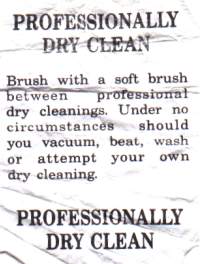Sunday, July 20, 2003
Concise Statement of Why
We have a down comforter on our bed. Because we have young kids, and because it is not unusual for one or more of the kids to end up crawling in bed with us, and because kids are kids, the comforter needs to be washed on occasion. On the comforter is this tag:

As you can see, this tag is pretty adamant about the fact that this comforter needs to be professionally dry cleaned. It is hard to misinterpret the phrase, "under no circumstances." But the obvious question is, Why? Manufacturers, government agencies, etc. would get a lot more mileage out of a tag like this if it included a Concise Statement of Why (CSW) so that people understood the reason for the warning.
Because it doesn't say why, and because you can readily find instructions for washing down comforters, down sleeping bags, down coats, etc. in books and on the Internet, we wash our comforter in water, throw it in the dryer for a couple of hours and it is fine. I half expect the comforter to spontaneously combust one night and burn the house down, but it hasn't happened yet. The other tag on the comforter says that it is made with 100% cotton filled with "all new material consisting of white goose down." Cotton and feathers are, as far as I know, washable. But maybe there truly is something that makes washing this comforter dangerous. If so, it would be nice to know what it is. A CSW would fill me in.
If you have ever been on an airplane flight, you know they are very big about making sure that your tray table and seatback are in the upright and locked position during takeoff and landing. Why? One day I asked the flight attendant after the flight. He had a very good explanation. Apparently the FAA runs tests on the time it takes to evacuate an aircraft, and if seatbacks and tray tables are down it adds time to an evacuation. That makes sense, so why not tell people that? Passengers would probably be a lot more likely to comply with the request if they knew the reason for it.
If you look on a bottle of chlorine or a bottle of ammonia (or household cleaners containing either chemical), the bottle often has a warning that says, "do not mix with other household cleaners." Why? Usually they don't tell you, but the reason is because the mixture of chlorine and ammonia will create pure chlorine gas in significant quantities, and the gas can be fatal. This page has a nice explanation of the reaction. If there was a Concise Statement of Why on the label, you'ld be less likely to make that mistake.
I have a bottle of acetaminophen (the ingredient in Tylenol) here that says, "Adults and children 12 years of age and over: 2 tablets every 4 hours, while symptoms persist, not to exceed 12 tablets in 24 hours, or as directed by a doctor." Why not exceed 12 tablets in 24 hours? Because, if you do, it is easy to overdose on acetaminophen. Your liver shuts down and then you die a couple of days later. The line between a "dose" of Tylenol and an "overdose" is a fine one. If the label stated that, people would be less likely to take too much.
And so on. Just about any warning label is guilty of omitting the reason why. If they would state the reason, we'd all be better off.
- 05/01/2003 - 06/01/2003
- 06/01/2003 - 07/01/2003
- 07/01/2003 - 08/01/2003
- 08/01/2003 - 09/01/2003
- 09/01/2003 - 10/01/2003
- 10/01/2003 - 11/01/2003
- 11/01/2003 - 12/01/2003
- 12/01/2003 - 01/01/2004
- 01/01/2004 - 02/01/2004
- 02/01/2004 - 03/01/2004
- 03/01/2004 - 04/01/2004
- 04/01/2004 - 05/01/2004
- 05/01/2004 - 06/01/2004
- 06/01/2004 - 07/01/2004
- 07/01/2004 - 08/01/2004
- 08/01/2004 - 09/01/2004
- 09/01/2004 - 10/01/2004
- 10/01/2004 - 11/01/2004
- 01/01/2005 - 02/01/2005
- 02/01/2005 - 03/01/2005
- 03/01/2005 - 04/01/2005
- 04/01/2005 - 05/01/2005
- 05/01/2005 - 06/01/2005
- 06/01/2005 - 07/01/2005
- 07/01/2005 - 08/01/2005
- 08/01/2005 - 09/01/2005
- 09/01/2005 - 10/01/2005
- 10/01/2005 - 11/01/2005
- 11/01/2005 - 12/01/2005
- 12/01/2005 - 01/01/2006
- 02/01/2006 - 03/01/2006
- 03/01/2006 - 04/01/2006
- 04/01/2006 - 05/01/2006
- 05/01/2006 - 06/01/2006
- 06/01/2006 - 07/01/2006
- 07/01/2006 - 08/01/2006
- 08/01/2006 - 09/01/2006
- 09/01/2006 - 10/01/2006
- 10/01/2006 - 11/01/2006
- 11/01/2006 - 12/01/2006
- 12/01/2006 - 01/01/2007
- 01/01/2007 - 02/01/2007
- 02/01/2007 - 03/01/2007
- 03/01/2007 - 04/01/2007
- 05/01/2007 - 06/01/2007
- 07/01/2007 - 08/01/2007
- 09/01/2007 - 10/01/2007
- 07/01/2008 - 08/01/2008
